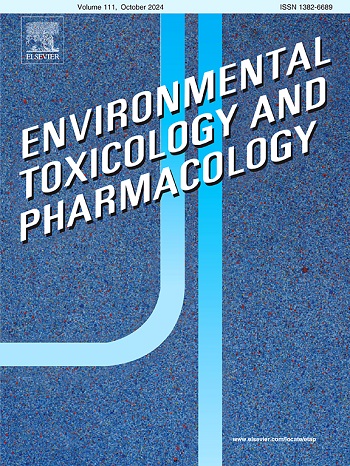Ex vivo electrophysiological evaluation of peripheral nerve functioning following exposition of adult mice to the organophosphorus pesticide chlormephos
IF 4.2
3区 环境科学与生态学
Q2 ENVIRONMENTAL SCIENCES
引用次数: 0
Abstract
The organophosphorus pesticide chlormephos was tested for its potential peripheral neurotoxicity by analyzing the diphasic compound action potential (CAP) of sciatic nerves isolated from adult mice chronically exposed to a sub-lethal dose of this pesticide, compared with control age-matched animals being only exposed to the vehicle. No significant modification was detected between chlormephos-exposed and control groups in their nerve responsiveness to stimulus. Furthermore, similar values of CAP kinetic variables were obtained from the two mouse groups. Finally, no abnormality concerning CAP refractory periods and responsiveness to high frequency stimulation (nerve fatigue) was exhibited by chlormephos-treated mice, when compared with control animals. These results complicate the screening for the potential neurotoxicity of organophosphates since they support the contention that the peripheral neuropathy induced by chronical exposition to sub-lethal doses of chlormephos is species dependents does not necessary correlate well with the clinical signs observed at the central nervous system level.
求助全文
约1分钟内获得全文
求助全文
来源期刊
CiteScore
7.00
自引率
4.70%
发文量
185
审稿时长
34 days
期刊介绍:
Environmental Toxicology and Pharmacology publishes the results of studies concerning toxic and pharmacological effects of (human and veterinary) drugs and of environmental contaminants in animals and man.
Areas of special interest are: molecular mechanisms of toxicity, biotransformation and toxicokinetics (including toxicokinetic modelling), molecular, biochemical and physiological mechanisms explaining differences in sensitivity between species and individuals, the characterisation of pathophysiological models and mechanisms involved in the development of effects and the identification of biological markers that can be used to study exposure and effects in man and animals.
In addition to full length papers, short communications, full-length reviews and mini-reviews, Environmental Toxicology and Pharmacology will publish in depth assessments of special problem areas. The latter publications may exceed the length of a full length paper three to fourfold. A basic requirement is that the assessments are made under the auspices of international groups of leading experts in the fields concerned. The information examined may either consist of data that were already published, or of new data that were obtained within the framework of collaborative research programmes. Provision is also made for the acceptance of minireviews on (classes of) compounds, toxicities or mechanisms, debating recent advances in rapidly developing fields that fall within the scope of the journal.

 求助内容:
求助内容: 应助结果提醒方式:
应助结果提醒方式:


